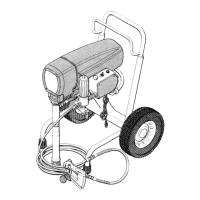6.
Place the flats of the rod in a vise.
CAUTION
Step
7,
tightening the piston valve into the rod, is
critical. Follow the procedure carefully to avoid
damaging the packings by overtightening.
7. Without changing the tightness of the nut against
the packings,
tighten the nut (214) into the piston
rod to
18
to
20
ft-lbs
(24
to 27 N.m). If the pen mark
on the packings loses alignment, back the nut off
and try again.
TORDUUJYJE c, ,.r#-203
1.34-3 Nam) 1
MARK
PACKINGS
AND HEX ALIGNMENT
213"
220"
205"
224
Fig 11
DO NOT LOSE
ALIGNMENT
Fig 12
8.
Stack the male gland (211”), packings (218”,
209")
and female gland (212*), one at a time, into the top
of the cylinder. See Fig 10.
9.
Install the throat packing nut (221) and plug (201)
but leave loose for now.
10. Insert the piston rod
(223)
through the bottom of
+he pump cylinder, pushing it up until the top of the
piston rod extends l-7/8” (32.2 mm) beyond the
top of the cylinder. See Fig 10.
11. Screw down the cylinder locknut (38) until it is
finger tight at the bottom of the external cylinder
threads.
12. Place flats of the intake valve in a vise. Install a new
gasket 006”) and screw the pump cylinder into the
valve. See Fig 9.
13.
Screw the displacement pump about
3/4
of the
way into the bearing housing
(27).
Hold the pin
(20)
up to the pin hole in the connecting rod assembly
(3)
and continue screwing in the pump until the pin
slides easily into th8 hole. Back off the pump until
the top threads of the pump cylinder are flush with
the face of the bearing housing and the outlet nip-
ple (45) is straight back. Push the retaining spring
(35) into the groove all the way around the connect-
ing rod. Tighten the locknut (38) very tight-about
70 ft-lb (94 N-ml-with a 2 in. open-end wrench
and 8 light hammer.
WARNING
Be sure the retaining spring (351 is firmly in the
groove of the connecting rod,
all the way around,
to prevent if from working loose due to vibration.
See Fig 13.
If the pin works loose, it or other parts could break
off due to the force of the pumping action. These
parts could be projected through the air and result
in serious bodily injury or property damage, in-
cluding damage to the pump, connecting rod or
bearing housing.
If the locknut (38) loosens during operation, the
threads of the bearing housing (27) will be per-
manently damaged. Be sure to tighten the locknut
firmly.
I
14. Tighten the packing nut (221)
just
enough to stop
leakage, but no tighter. Fill the wet-cup/packing
nut l/3 full with Grace TSL.
15. Replace the motor brushes, included with the repair
kit. See page 18.
FACE OF
BEARING
HOUSING
b?
TORQUE TO
m ft-lb
I
(94 N.ml
Fig 13
307-643 17

